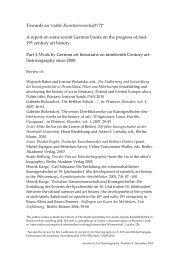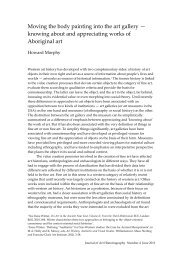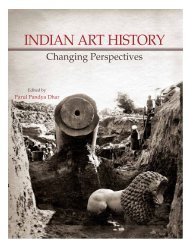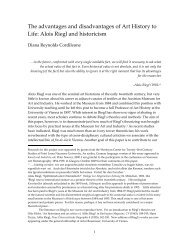9/CCG1 - Journal of Art Historiography
9/CCG1 - Journal of Art Historiography
9/CCG1 - Journal of Art Historiography
Create successful ePaper yourself
Turn your PDF publications into a flip-book with our unique Google optimized e-Paper software.
Carolyn C. Guile<br />
Winckelmann in Poland: An Eighteenth-Century<br />
Response to the ‘History <strong>of</strong> the <strong>Art</strong> <strong>of</strong> Antiquity’<br />
and Far Eastern art and architecture. With this work he was able to capture the<br />
attention <strong>of</strong> a German publishing house; G.M. Walther, the Dresden publisher <strong>of</strong><br />
Winckelmann’s text, considered publishing a German translation <strong>of</strong> Potocki’s<br />
writings on Near and Far Eastern arts, and ultimately published them in part. 4<br />
Undoubtedly with a German (as well as a Polish) audience in mind, Potocki<br />
connected his On the <strong>Art</strong> <strong>of</strong> the Ancients to German antiquarian scholarly traditions<br />
by framing his opening discussion as an engagement with the deceased<br />
Winckelmann ─ an authority he respected and admired ─ and responding to those<br />
who had attacked Winckelmann, in particular the renowned Göttingen antiquarian,<br />
Christian Gottlob Heyne (1729-1812). The work represents Potocki’s response to<br />
particular positions articulated in the literature <strong>of</strong> continental connoisseurship and<br />
antiquarianism at a time when art history itself was an emergent discipline. More<br />
than a direct translation, Potocki’s project assessed the utility <strong>of</strong> Winckelmann’s<br />
method and discussed the notions <strong>of</strong> universal aesthetic values on the one hand,<br />
and cultural difference across geographies on the other, refuting Heyne along the<br />
way ─ as if to ensure that Winckelmann would properly be understood in relation<br />
to the more important historiographical issues that in Potocki’s view eluded<br />
antiquarians and their method <strong>of</strong> studying the past. In On the <strong>Art</strong> <strong>of</strong> the Ancients, as<br />
in his other writings, Potocki’s embrace <strong>of</strong> the Greek tradition as the source <strong>of</strong><br />
broadly European ones by extension secured for Poland a place in relation to that<br />
common point <strong>of</strong> reference. Written by a thinker at home in the Republic <strong>of</strong> Letters,<br />
one deeply suspicious <strong>of</strong> revolution and who at the same time expressed strong<br />
anticlerical positions, The Polish Winckelmann reads as a work in progress, an art<br />
history <strong>of</strong> considerable heft informed by close consultation with primary sources<br />
and several trips to Italy from a terrain that was difficult to traverse and deemed<br />
both remote and, in ways, uncivilized by continentals. The achievement for Poland<br />
in his view resided in the expression <strong>of</strong> these ideals in the Polish language, through<br />
which he could facilitate a local enlightenment. The importance <strong>of</strong> the text extends<br />
far beyond local ‘Polish’ issues, however. In Winckelmann’s History, Potocki felt he<br />
had found the key to understanding principles that were supranational for their<br />
proclaimed universality and that could cross cultural lines where politics itself did<br />
not. It therefore contains the possibility <strong>of</strong> expanding an understanding <strong>of</strong> the<br />
trajectory and reach <strong>of</strong> enlightened ventures, and by extension <strong>of</strong> necessarily<br />
broadening enlightenment studies beyond traditional boundaries.<br />
Addressing the need for an art historical work <strong>of</strong> such importance as<br />
Winckelmann’s in the Polish language where there existed a conspicuous lacuna,<br />
Potocki aimed to underline the connection between the Commonwealth’s cultural<br />
identity and Greco-Roman artistic heritage, and to reflect on the differences between<br />
and among cultures both within and outside the borders <strong>of</strong> the Christendom that<br />
visual heritage so pr<strong>of</strong>oundly and variously shaped, so as to demonstrate that taste<br />
4 Jolanta Polanowska, Stanisław Kostka Potocki, 1755-1821: Twórczość architekta amatora, przedstawiciela<br />
neoklasycyzmu i nurtu picturesque, Warsaw: Instytut Sztuki PAN, 2009, 63 n.43.<br />
3
















